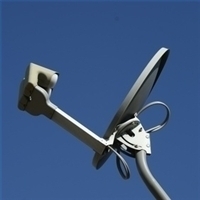Alignment satellite dish
A DirecTV satellite dish may need realignment when strong winds, accidental movement, and various other situations occur. It may also become necessary to set up a dish that has come loose or one that was purchased without an installation plan. Whatever the case, individuals can alight the DirecTV dish on their own.
Checking the Signal Strength

Turn on a tv with a DirecTV receiver connected and in the options menu (press the menu button on the DirecTV remote) select "Settings."
Note: The settings option may be grouped with parental settings or favorite channels.
From the Settings menu select "System Setup." Select "Satellite" and choose "Signal Strength, " which will give the signal strength reading with the satellite dish in the current configuration. "Signal Meters" may also have to be selected to show the satellite signal strength.
Typically, an acceptably aligned satellite dish needs to have between 75% and 100% signal strength to function well. If it is below 70%, choppy video, video outage during heavy weather, and other problems may be experienced.
Aligning the Dish
Dish alignment may be necessary to ensure better video quality and connection with the satellite signal. DirecTV uses satellites that are located in the Southern portion of the sky, thus the satellite dish must be pointing to the South in order to locate a signal.
The satellite dish must be set to a 51 degree elevation. The back of the dish should be attached to a bracket that can be adjusted. A small meter on the side of the bracket gives the current setting for the dish. If the dish is not at 51 degrees, loosen and adjust it using the meter as a guide.
Note: The bracket must be level in order to get the correct 51 degree measurement with the meter.
There should be nothing obstructing the view of the southern sky where the dish is pointing. If there are obstructions (such as new tree growth), they must be removed. Otherwise the dish has to be moved to another location.
Loosen the mast (pole) enough to be able to gently move the dish left and right. This will allow the signal being received through the dish to be fine tuned, and can be done with the receiver's system menu. Use the instructions for checking the signal strength to view the current signal on the receiver.
Note: An additional person is often needed to relay the numbers on the screen. When the mast is turned slightly, wait a few seconds for the receiver to update.
Once the signal is as close to 100% as possible, tighten all bolts or nuts on the satellite dish assembly to lock it into place. This will help to prevent misalignment in the future due to bad weather, large birds resting on the dish, etc.
Note: For a variety of reasons, not all dishes are capable of reaching 100% signal. A cloudy day may impair the reading of the received signal. Try to align on a clear day for best results.
Related posts:

 How to make squash How to remote control desktop using lan tricks Tricks for keeping marks off your nose when wearing sunglasses Quickbooks help how to enter tips…
How to make squash How to remote control desktop using lan tricks Tricks for keeping marks off your nose when wearing sunglasses Quickbooks help how to enter tips… As both J.D. Power and Associates and Consumer Reports have noted, satellite enjoys a superior customer service rating among its multichannel competitors. Sustaining…
As both J.D. Power and Associates and Consumer Reports have noted, satellite enjoys a superior customer service rating among its multichannel competitors. Sustaining… What does tin stand for Tips on how to breed better dragons in dragonvale Linus tech tips how to build a pc what does negative mean what is capital murders mean…
What does tin stand for Tips on how to breed better dragons in dragonvale Linus tech tips how to build a pc what does negative mean what is capital murders mean… Simply activate the receiver through an existing DISH account or subscribe to a new Pay-As-You-Go programming package. Pathway X2 can point to either Western or…
Simply activate the receiver through an existing DISH account or subscribe to a new Pay-As-You-Go programming package. Pathway X2 can point to either Western or… A Dish Network digital video recorder (DVR) is controlled by a specialized remote that is provided with it. The Dish Network remote uses a code that allows it to…
A Dish Network digital video recorder (DVR) is controlled by a specialized remote that is provided with it. The Dish Network remote uses a code that allows it to…